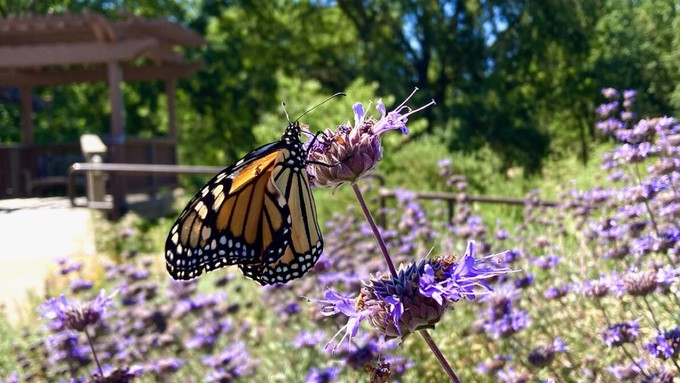
Order plants online, then pick up at Rancho Cordova nursery

A monarch butterfly pauses on the blossom of a salvia clevelandii at the Cosumnes Preserve. Photo courtesy Robin Rogerson via Sac Valley CNPS
In time for fall planting, the Sacramento Valley chapter of the California Native Plant Society (CNPS) is hosting its online fall plant sale at its nursery, starting at noon Wednesday through Sunday, Sept. 14-18.
Orders are available for pickup on two Sundays, Sept. 25 and Oct. 4. The demonstration gardens also will be open for viewing; see website for availability.
Also known as Elderberry Farms, Sac Valley CNPS Nursery and Gardens are located at Soil Born Farms’ American River Ranch, 2140 Chase Drive, Rancho Cordova.
Fall is the best time to transplant most native plants, especially shrubs, trees and perennials. It allows them months (hopefully with rain) to put down roots and get established before the stress of summer heat next year.
“Native plants are not only beautiful and climate adaptable, but they also feed and shelter birds, bees, butterflies and other pollinators,” says Chris Lewis, the nursery’s longtime director.
Gardeners gravitate towards native plants, too; they naturally use less water. Survival of our dry summer weather is stamped into these plants’ DNA. Many varieties need little if any summer irrigation.
Not only do native plants save water compared to traditional lawn-based landscape, they support local wildlife. Providing flowers and often seeds or berries, native plants offer food for pollinators and birds; that’s something turf never does.
Among the native favorites offered by the nursery: Monkeyflower, buckwheat, lupine, penstemon, salvias, asters, redberry, mountain mahogany and, of course, elderberry.
For full details and plant list: https://www.sacvalleycnps.org/plant-sales/.
Comments
0 comments have been posted.Sacramento Digs Gardening to your inbox.
Food in My Back Yard Series
May 6: Maintain soil moisture with mulch for garden success
April 29: What's (already) wrong with my tomato plants?
April 22: Should you stock up on fertilizer? (Yes!)
April 15: Grow culinary herbs in containers
April 8: When to plant summer vegetables
April 1: Don't be fooled by these garden myths
March 25: Fertilizer tips: How to 'feed' your vegetables for healthy growth
March 18: Time to give vegetable seedlings some more space
March 11: Ways to win the fight against weeds
March 4: Potatoes from the garden
Feb. 25: Plant a fruit tree now -- for later
Feb. 18: How to squeeze more food into less space
Feb. 11: When to plant? Consider staggering your transplants
Feb. 4: Starting in seed starting
Sites We Like
Garden Checklist for week of May 11
Make the most of the lower temperatures early in the week. We’ll be back in the 80s by Thursday.
* Plant, plant, plant! It’s prime planting season in the Sacramento area. Time to set out those tomato transplants along with peppers and eggplants. Pinch off any flowers on new transplants to make them concentrate on establishing roots instead of setting premature fruit.
* Direct-seed melons, cucumbers, summer squash, corn, radishes, pumpkins and annual herbs such as basil.
* Harvest cabbage, lettuce, peas and green onions.
* In the flower garden, direct-seed sunflowers, cosmos, salvia, zinnias, marigolds, celosia and asters. (You also can transplant seedlings for many of the same flowers.)
* Plant dahlia tubers.
* Transplant petunias, marigolds and perennial flowers such as astilbe, columbine, coneflowers, coreopsis, dahlias, rudbeckia and verbena.
* Keep an eye out for slugs, snails, earwigs and aphids that want to dine on tender new growth.
* Feed summer bloomers with a balanced fertilizer.
* For continued bloom, cut off spent flowers on roses as well as other flowering plants.
* Add mulch to the garden to maintain moisture. Mulch also cuts down on weeds. But don’t let it mound around the stems or trunks of trees or shrubs. Leave about a 6-inch-to-1-foot circle to avoid crown rot or other problems.
* Remember to weed! Pull those nasties before they set seed.
* Water early in the day and keep seedlings evenly moist.